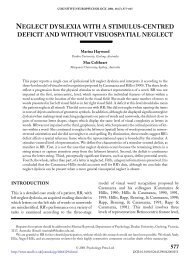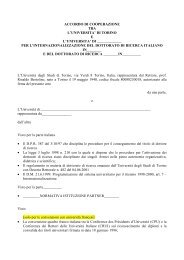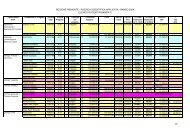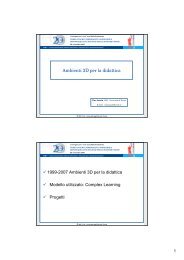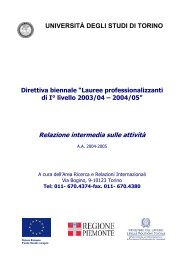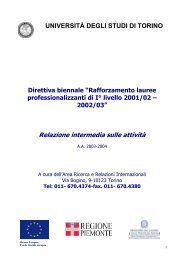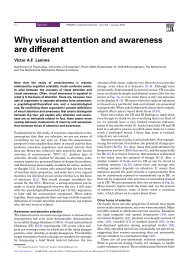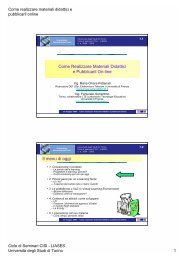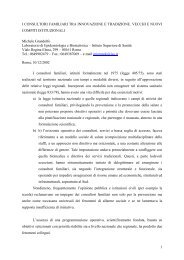Spatial hemineglect in humans - Cisi
Spatial hemineglect in humans - Cisi
Spatial hemineglect in humans - Cisi
You also want an ePaper? Increase the reach of your titles
YUMPU automatically turns print PDFs into web optimized ePapers that Google loves.
G. Kerkho€ / Progress <strong>in</strong> Neurobiology 63 (2001) 1±27 5<br />
Similarly, neglect patients overreproduce a horizontal<br />
distance displayed <strong>in</strong> their contralesional hemispace<br />
when the ``reference'' distance is displayed <strong>in</strong> their ipsilesional<br />
space (Fig. 1C). The same phenomenon is<br />
observed when a horizontal bar has to be reproduced<br />
<strong>in</strong> the left hemispace (Fig. 1D). Here patients reproduce<br />
the bar <strong>in</strong> the contralesional hemispace too long,<br />
which has been termed ``size distortion'' (Harvey et al.,<br />
1995; Milner and Harvey, 1995; Milner et al., 1998).<br />
In contrast, neglect patients show veridical cod<strong>in</strong>g of<br />
vertical bars (Fig. 1E) and of symmetrical, global<br />
shapes like circles (Fig. 1F). This disturbed size cod<strong>in</strong>g<br />
may rema<strong>in</strong> a purely perceptual phenomenon s<strong>in</strong>ce it<br />
does not necessarily imply disturbed adjustment of ®nger<br />
grip aperture when scal<strong>in</strong>g the size of an object <strong>in</strong><br />
grasp<strong>in</strong>g (Pritchard et al., 1997). Together, these<br />
results <strong>in</strong>dicate a non-veridical cod<strong>in</strong>g of with<strong>in</strong>-object<br />
(length of an object) and between-object (distance<br />
between objects) spatial extension <strong>in</strong> the horizontal<br />
plane which is not found when vertical size cues are<br />
apparent. The advanced <strong>in</strong>terpretation for these allocentric<br />
spatial disorders is that the contralesional hemispace<br />
appears ``constricted'' or ``distorted'' <strong>in</strong> relation<br />
to the ipsilesional hemispace (Milner et al., 1998). As a<br />
consequence, elongated objects presented <strong>in</strong> this hemispace<br />
have to be larger <strong>in</strong> order to match the length of<br />
an object <strong>in</strong> ipsilesional hemispace. This has been<br />
found for horizontal object-size, and as well for the<br />
horizontal distance between objects (Kerkho€, 2000;<br />
see also Karnath and Ferber, 1999 for di€erent results<br />
and <strong>in</strong>terpretations). Measures of perceptual distortions<br />
<strong>in</strong> patients with neglect may be quite sensitive<br />
s<strong>in</strong>ce they may reveal size distortions even after apparent<br />
recovery of other signs (l<strong>in</strong>e bisection; Harvey and<br />
Milner, 1999).<br />
4. Egocentric spatial de®cits<br />
Fig. 2. Representative egocentric de®cits <strong>in</strong> neglect. (A) Deviated<br />
visual judgments of neglect patients (without visual ®eld defects)<br />
when <strong>in</strong>dicat<strong>in</strong>g the position of a diode <strong>in</strong> total darkness <strong>in</strong> relation<br />
to their bodily subjective straight ahead position. The judgments<br />
were similarly shifted to the ipsilesional, right side <strong>in</strong> two distances<br />
(1.2 and 3 m), <strong>in</strong>dicat<strong>in</strong>g a rotation of the visual subjective straight<br />
ahead (SSA) <strong>in</strong> front space (redrawn after Ferber and Karnath,<br />
1999). (B) Ipsilesionally shifted visual search area <strong>in</strong> total darkness<br />
(solid l<strong>in</strong>e) and similarly shifted tactile search area (with the ipsilesional<br />
hand, not drawn) with bl<strong>in</strong>dfolded neglect patients (cf. Karnath<br />
and Peren<strong>in</strong>, 1998). Search areas are drawn schematically and<br />
not to scale. (C) Judgments of the subjective visual and tactile vertical,<br />
horizontal and oblique orientation matches <strong>in</strong> a patient with leftsided<br />
neglect (upper two polar plots) and a matched normal subject<br />
(lower two plots). Each th<strong>in</strong> black l<strong>in</strong>es represents the result of one<br />
trial. Visual tests were taken with stimuli displayed on a PC-screen<br />
via software (Kerkho€ and Marquardt, 1995), tactile tests employed<br />
the judgment of a metal bar mounted on a vertical board <strong>in</strong> front of<br />
the patient (Kerkho€, 1999a). Note the counterclockwise tilt of perceptual<br />
judgments <strong>in</strong> both modalities <strong>in</strong> the neglect patient. Together,<br />
these results <strong>in</strong>dicate a subjective rotation of sensory space <strong>in</strong> the<br />
frontal plane go<strong>in</strong>g beyond the shift of the SSA <strong>in</strong> the sagittal plane<br />
(A) <strong>in</strong> neglect patients.<br />
It is a relatively new idea that neglect is not only<br />
found <strong>in</strong> relation to the left half of space but more<br />
precisely <strong>in</strong> relation to what is left of the patient's<br />
trunk midl<strong>in</strong>e, head sagittale or even the position of<br />
the patient's hand <strong>in</strong> space. In one of the early studies<br />
on that topic (Heilman et al., 1983) neglect patients<br />
were required to po<strong>in</strong>t towards their subjective straight<br />
ahead (SSA) <strong>in</strong> relation to their trunk midl<strong>in</strong>e. The<br />
patients' responses were ipsilesionally deviated to the<br />
right side while non-neglect<strong>in</strong>g patients with left hemispheric<br />
lesions showed quite accurate po<strong>in</strong>t<strong>in</strong>g results.<br />
Similar results are obta<strong>in</strong>ed when neglect patients have<br />
to <strong>in</strong>dicate their visual SSA without po<strong>in</strong>t<strong>in</strong>g (Fig. 2A).<br />
If egocentric de®cits are related to the body midl<strong>in</strong>e<br />
or certa<strong>in</strong> body parts modi®cations of their position <strong>in</strong><br />
space might <strong>in</strong>¯uence neglect. In an early study exam<strong>in</strong><strong>in</strong>g<br />
this question (Bisiach et al., 1985), neglect<br />
patients had to tactually explore a honeycomb-shaped<br />
board with their ipsilesional hand to ®nd a marble.<br />
The authors found that neglect covaried with the position<br />
of the trunk-vertical axis and with the head/eyeaxis.<br />
Shift<strong>in</strong>g either the trunk or the head to the left <strong>in</strong><br />
relation to the stationary honeycomb-board reduced<br />
the number of omissions <strong>in</strong> the tactile neglect task.<br />
Karnath (summarized <strong>in</strong> Karnath, 1997) has <strong>in</strong>vestigated<br />
the <strong>in</strong>¯uence of body-and-head position <strong>in</strong> more<br />
detail. In a saccadic reaction-time study, it was found<br />
that leftward trunk-rotation but not head-rotation<br />
improved the delayed reactions to visual targets<br />
appear<strong>in</strong>g <strong>in</strong> contralesional hemispace (Karnath et al.,




